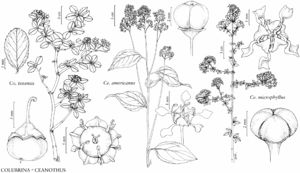Ceanothus americanus
Sp. Pl. 1: 195. 1753.
Shrubs, deciduous, 0.8–1.5 m. Stems erect to ascending, not rooting at nodes; branchlets usually green, sometimes reddish-brown, not thorn-tipped, round or slightly angled in cross-section, flexible, puberulent, glabrescent. Leaves: petiole 4–13 mm; blade not aromatic, flat, ovate to ovate-oblong, (20–) 30–100 × 15–64 mm, herbaceous, not resinous, base rounded, margins serrate to serrulate, teeth 54–130+, apex usually acuminate to acute, rarely obtuse, abaxial surface pale green, puberulent, especially on veins, adaxial surface dark green, dull, puberulent, especially on major veins; 3-veined from base. Inflorescences terminal or axillary, paniclelike, cylindric to conic, 3–14 cm. Flowers: sepals, petals, and nectary white. Capsules 4–6 mm wide, not lobed; valves ± rugulose, crested. 2n = 24.
Phenology: Flowering May–Aug.
Habitat: Open areas in forests and woodlands, abandoned fields, sandhills, prairies.
Elevation: 80–300 m.
Distribution

Ont., Que., Ala., Ark., Conn., Del., D.C., Fla., Ga., Ill., Ind., Iowa, Kans., Ky., La., Maine, Md., Mass., Mich., Minn., Miss., Mo., Nebr., N.H., N.J., N.Y., N.C., Ohio, Okla., Pa., R.I., S.C., Tenn., Tex., Vt., Va., W.Va., Wis.
Discussion
Ceanothus americanus is closely related to C. herbaceus and C. sanguineus. Ceanothus herbaceus differs in having narrower leaf blades, short peduncles, and globose to hemispheric inflorescences. Ceanothus sanguineus, which occurs in western North America (except for a disjunct population in the Upper Peninsula of Michigan), differs by smooth fruit valves and inflorescences borne on stems older than the current year. Three varieties, var. americanus, var. intermedius, and var. pitcheri, have been recognized within C. americanus, based on leaf shape and indumentum (M. L. Fernald 1950; H. A. Gleason and A. Cronquist 1991), but N. C. Coile (1988) provided evidence for clinal intergradation among them.
An infusion of Ceanothus americanus leaves or bark was used widely by Native Americans as an anti-inflammatory and to treat gastrointestinal ailments (D. E. Moerman 1998). The dried leaves were used as a tea substitute during the American Revolution (N. L. Britton and A. Brown 1896–1898, vol. 2).
Selected References
None.
Lower Taxa
"thin" is not a number.
